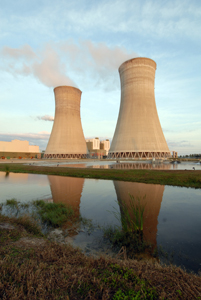Generation Units
Environmental Performance
To prevent air pollution, Stanton Energy Center (SEC) uses low-sulfur, low-ash coal and operates state-of-the-art pollution control equipment to remove pollutants. State-certified instruments continuously monitor emissions to verify actual removal. The Florida Department of Environmental Protection reviews air-monitoring data from SEC. Air sampling has shown that Stanton’s emissions are among the lowest of any coal-fired plant in the nation.
Environmental Protection Measures
Coal burning in the boiler creates gaseous and particulate (solid) by-products called flue gas. Particulates, Nitric Oxides (NOx), and Sulfur Oxides (S02) are present in the flue gas. Emissions of these by-products are monitored closely by the Stanton Energy Center to ensure adherence to established governmental environmental standards.
Unit 2: NOx is controlled by efficient low-NOx burners and Selective Catalytic Reduction equipment (Unit 1 also uses low-NOx burners). Burners are designed to minimize NOx by burning at low temperatures with a minimum amount of turbulence and utilizing as much time as possible to complete the burn. The Selective Catalytic Reduction process converts NOx to harmless nitrogen (N2) and water (H2O) by spraying ammonia (NH3) into the flue gas and allowing the flue gas to pass through a catalyst material to enhance the chemical reaction.
Units 1 and 2: Particulates are controlled in an electrostatic precipitator. This equipment electrically charges the solid particles (fly ash) so that they will be attracted to oppositely charged plates. Large hammers periodically hit the plates causing the fly ash to fall to the bottom of the precipitator so that a vacuum system can transport it for storage in a silo.
S02 is controlled by a wet limestone scrubber. In the scrubber, a limestone and water slurry (scrubber slurry) is sprayed over the flue gas. The S02 reacts chemically with the limestone and water slurry in the flue gas and becomes a suspended solid in the scrubber slurry. As this process continues, the scrubber slurry increases in solid content and becomes more acidic. To maintain this chemistry in a balance, spent scrubber slurry is removed as new fresh slurry is added. The spent scrubber slurry is transported away for the disposal process.
 The fly ash removed in the electrostatic precipitator and the spent scrubber sludge from the flue gas scrubber are mixed with lime. Adding lime to this mixture causes the material to harden much like concrete. This material is transported to the Combustion Waste Storage Area near the western boundary of the site. After placement, this material is compacted, contoured, covered with topsoil and seeded.
The fly ash removed in the electrostatic precipitator and the spent scrubber sludge from the flue gas scrubber are mixed with lime. Adding lime to this mixture causes the material to harden much like concrete. This material is transported to the Combustion Waste Storage Area near the western boundary of the site. After placement, this material is compacted, contoured, covered with topsoil and seeded.
Material deposited in this landfill is environmentally stable. Since it is essentially impervious, it will not contaminate the groundwater. Monitoring wells are placed throughout the site to ensure that the groundwater has not been contaminated.